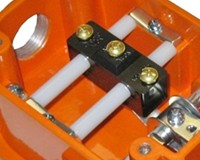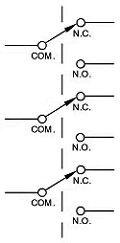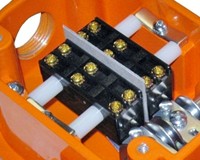Foot switches can be used to turn electrical equipment on and off with the foot, freeing the hands to perform other operations or providing ergonomic improvement to a workstation. Foot switch and foot pedal applications often require specific electrical ratings, enclosures, pedal actions, cables, and other variations. When you’re ready to order, just select the product that you need with appropriate options and we’ll get it shipped to you as fast as we can. We also offer customization for manufacturers — contact us today with your specifications.
Choose the Foot Switch That’s Right for Your Application
Safety and Selection WARNING: Before selecting or using any foot switch, read the foot switch safety warning. Only the user can be aware of all conditions and factors present during the installation, operation, and maintenance of a foot switch and the surrounding work area. Therefore, only the user can determine which foot switch(es) and which point-of-operation safeguards are required for a particular application or work station. Review OSHA and other regulations before selecting or installing any foot switch. Safety options can include guards to protect against accidental activation, anti-trip safety latches (G-Series only), enclosures ratings, and front access gates.
Model Overview
The shape (form factor) and function required by a foot switch pedal application will help determine which model will be needed (in addition to electrical requirements). Some considerations include size, weight, material, shape, enclosure rating, guarding options, and other factors.
Foot Switches
Potentiometer foot pedals
Foot Switch Pedal Action
There are two main types of pedal action: momentary and maintained.
1) Momentary Action: Press and hold to turn on, release to turn off (like a car horn). The user must continue to hold the pedal down to keep it on. As soon as the user lifts his or her foot, the unit will turn off. This is the most common type of foot switch pedal action.
2) Maintained Action: Press pedal once to turn on, press again to turn off (like a light switch). The foot switch will stay on and the user can remove his or her foot from the pedal until the user presses the pedal again to turn it off. Examples include: G-Series -MA models (press down on pedal to turn it on, then press forward a latch inside the hood to return the pedal back to the off position); S420-Series models (press opposite ends of the pedal to toggle it on and off); and F300-Series models (has push on / push off maintained action, like a ball-point pen).
Additionally, the Anti-Trip Safety Latch is available on the G-Series models. For this action, you have to press forward a latch inside the guard before you can press down on the pedal.
Electrical Circuitry and Contacts
Choosing the proper current and voltage rating for a foot switch application will depend on the electrical circuit of the equipment that the foot switch is attached to. The amount of electrical current that will flow through the circuit will determine the amperage rating required for the foot switch. The voltage and horsepower ratings (if applicable) also must be selected appropriately for the application. Consult a certified electrician with any questions to determine the amperage, voltage, grounding, and power requirements for your application. Follow all local and national electrical safety regulations.
Typically, foot switches contain SPDT contacts that are wired “normally open.” That is, the switch is open, or “off,” when not in use, and not activated until pressed. However, other circuit variations are available and it will depend on the requirements for your application. See our glossary for more description about foot switch terms and concepts: foot switch glossary page
Foot Switch Wiring Diagrams and Circuit Images
Many SSC Controls foot switches come with cables already attached. Two of the most common cable examples are listed below: cables with a piggyback plug, and cables with leads. Each of these cable configurations can be included on the S-Series, B-Series, and F-Series foot switch product lines. The circuits below are shown in the “off” or at-rest position, with the pedal fully up.
Danger: Disconnect input power before performing any installation or maintenance. Only a qualified electrician should install any foot switch, including proper grounding and installation per local and national electrical codes.
Example (S, B, F)
Description
Switch Circuit
Foot Switch Wiring Diagrams and Notes
G-Series heavy-duty foot switches (see below for wiring diagrams) can include from one to three switches, and up to four independent SPDT circuits. They do not come with cables. The user installs the appropriate cable and strain relief to the switch. G500 models have one switch, G502 models have two switches, and G503 models have three switches. For models with two or more switches (G502, G503, or G504), both switches can be independently adjusted, and can be set so one switch goes off before the other, or at the same time. If both switches are set to go off at the same time in the G502, the unit will have DPDT circuitry. Below are examples of the circuitry of different G-Series foot switches. The circuits below are shown in the “off” or at-rest position, with the pedal fully up.
Example (G-Series)
Examples of G-Series Foot Switches
Switch Circuit
Inside Image
- Model Example: G500-MO
- Circuit: SPDT (single-pole double-throw)
- Includes one SPDT switch for simple on/off.


- Model Example: G502-MO
- Circuit: DPDT (double-pole double-throw)
- Includes two SPDT switches that can be set to activate separately or at the same time.



(See the G-Series Product Page for a complete list of models and options.)
- Model Example: G503-MO
- Circuit: TPDT (triple-pole double-throw)
- Includes three SPDT switches that can be set to activate separately or at the same time.


- Model Example: G504-MO
- Circuit: Dual DPDT (two DPDT switches in each unit)
- Ideal for controlling up to four independent circuits.


- Model Example: G500-MO-DB
- Circuit: SPDT-DB (single-pole double-throw double-break)
- Double-break contacts make connection at two points on each line, enabling the switch to have improved performance and life in some DC circuits.
- Also called “Form Z” contacts.
- Order by selecting the “-DB” double-break option on the model page.



Additional notes:
- All foot switches should be properly grounded per local and national electrical codes.
- Two-stage models (models ending in “-2S”, such as G502-MO-2S) have an additional spring mechanism that provides an extra force in between the activation of each switch. The user will feel the additional force after activating the first switch when pressing halfway down on the pedal; the user can then either hold at that position or continue pressing the pedal down to activate the second switch.
- G-Series foot switches are available with other options, such as the Front Gate (-GT models), the Anti-Trip Safety Latch (-AT), and Maintained Action (-MA). However, the switch circuitry shown above stays the same for these option
Foot Switch Wiring and Installation (For One SPDT Circuit Wired Normally Open)
Warning: Disconnect input power before installing or servicing any foot switch. Please review the Foot Switch Safety and Selection WARNING before selecting, installing, servicing, or using any foot switch. The buyer (and user) is responsible for proper foot switch selection, installation, safety, and application. The following installation instructions are general guidelines, and each application may require steps or connections different from those listed below.
Foot Switches that come with the piggyback plug (3-pronged NEMA 5-15 series P/R):
Foot Switches that come with cable that have leads (wires) on the end of the cable:
Foot Switches that come with no wiring or cable:
Enclosure Rating
In addition to electrical ratings and the size or shape of the foot switch, the enclosure rating is one of the most important factors to consider when choosing a foot switch for a particular application. Foot switches typically require one of the following enclosure ratings (for non-hazardous locations), as defined by UL, CSA, and NEMA (see also www.ssccontrols.com/enclosures):
Additional References and Safety Warnings
- SSC Controls — Glossary
- SSC Controls — Foot Switch Safety Warning
- Machine guarding of presses (OSHA)
- Occupational Safety and Health Association (OSHA)National Electrical Manufacturers Association (NEMA)
- Switch circuitry and switches from Wikipedia
- General resource about electric circuits from allaboutcircuits.com
- General resource about home electrical systems
- More about switch contacts
Cable and Connector Options
Footswitches can be shipped with a variety of cable options (see examples below), connectors, and plugs. Modifications for OEM applications (anything that is not a standard SSC product, as listed on the product pages) typically require a 100 unit minimum. For information about special OEM modifications, please contact us by phone at 1-440-205-1600 or by email.









